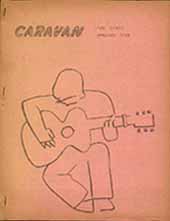Difference between revisions of "Caravan"
(added info) |
m |
||
| Line 4: | Line 4: | ||
With encouragement from friends, folk music fan Lee Hoffman began publishing ''Caravan'' in the 1950's. Folk musician Dave Van Ronk wrote a column under the penname "Blind Rafferty" and English fan John Brunner contributed a column of folk music news from the UK. The first issue of one hundred copies were mimeographed and hand assembled, which were distributed by Lee for free in Washington Square Park. | With encouragement from friends, folk music fan Lee Hoffman began publishing ''Caravan'' in the 1950's. Folk musician Dave Van Ronk wrote a column under the penname "Blind Rafferty" and English fan John Brunner contributed a column of folk music news from the UK. The first issue of one hundred copies were mimeographed and hand assembled, which were distributed by Lee for free in Washington Square Park. | ||
| − | After people started dropping in to | + | After people started dropping in to The Folklore Center looking for copies, owner Izzy Young asked Lee to let him put ''Caravan'' on his counter for sale and the zine took off. |
Eventually ''Caravan'' grew to include articles, columns, letters, reviews news of coming events and a page of brief "Social Notes From All Over", which consisted mostly of the goings-on of the Washington Square crowd. Aaron Rennert and Ray Sullivan contributed photographs, which were featured on the covers of later issues. Roger Lass and Barry Kornfeld served as assistant editors. Caravan's circulation grew to 2,000 copies an issue, and the only way to keep it going was to have it printed professionally. At this point Hoffman began taking on advertisers to offset the costs of running the zine. | Eventually ''Caravan'' grew to include articles, columns, letters, reviews news of coming events and a page of brief "Social Notes From All Over", which consisted mostly of the goings-on of the Washington Square crowd. Aaron Rennert and Ray Sullivan contributed photographs, which were featured on the covers of later issues. Roger Lass and Barry Kornfeld served as assistant editors. Caravan's circulation grew to 2,000 copies an issue, and the only way to keep it going was to have it printed professionally. At this point Hoffman began taking on advertisers to offset the costs of running the zine. | ||
Revision as of 12:16, 11 February 2011
Caravan was a fanzine devoted to folk music published by Lee Hoffman in New York, U.S.A.
With encouragement from friends, folk music fan Lee Hoffman began publishing Caravan in the 1950's. Folk musician Dave Van Ronk wrote a column under the penname "Blind Rafferty" and English fan John Brunner contributed a column of folk music news from the UK. The first issue of one hundred copies were mimeographed and hand assembled, which were distributed by Lee for free in Washington Square Park.
After people started dropping in to The Folklore Center looking for copies, owner Izzy Young asked Lee to let him put Caravan on his counter for sale and the zine took off.
Eventually Caravan grew to include articles, columns, letters, reviews news of coming events and a page of brief "Social Notes From All Over", which consisted mostly of the goings-on of the Washington Square crowd. Aaron Rennert and Ray Sullivan contributed photographs, which were featured on the covers of later issues. Roger Lass and Barry Kornfeld served as assistant editors. Caravan's circulation grew to 2,000 copies an issue, and the only way to keep it going was to have it printed professionally. At this point Hoffman began taking on advertisers to offset the costs of running the zine.
After a few more issues Hoffman decided it was becoming more work than fun so she sold the zine to Billy Faier and started over again with another small mimeographed fanzine called Gardyloo, named after the traditional cry of warning before one dumped a bucket of slops out of an upstairs window.
